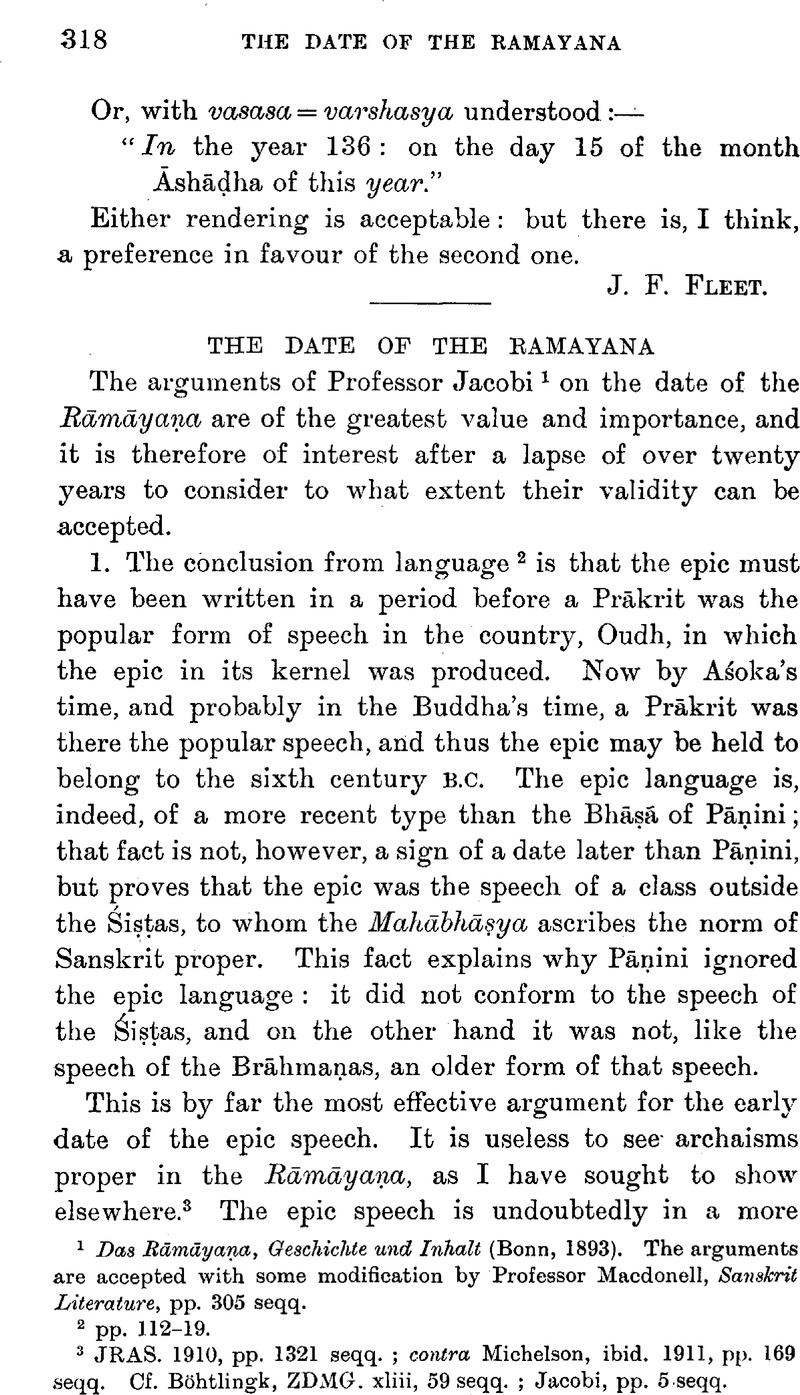Article contents
The Date of the Rāmāyaṇa
Published online by Cambridge University Press: 15 March 2011
Abstract

- Type
- Miscellaneous Communications
- Information
- Copyright
- Copyright © The Royal Asiatic Society 1915
References
page 318 note 1 Das Rāmāyaṇa, Geschichte und Inhalt (Bonn, 1893)Google Scholar. The arguments are accepted with some modification by ProfessorMacdonell, , Sanskrit Literature, pp. 305 seqq.Google Scholar
page 318 note 2 pp. 112–19.
page 318 note 3 JRAS. 1910, pp. 1321Google Scholar seqq.; contra Michelson, ibid. 1911, pp. 169 seqq. Cf. Böhtlingk, , ZDMG. xliii, 59 seqq.Google Scholar; Jacobi, , pp. 5 seqq.Google Scholar
page 319 note 1 v, 30. 17, 18.
page 319 note 2 See Jacobi, , pp. 62–3Google Scholar, and cf. Hertel, , Tantrākhyāyika, pp. 8 seqq.Google Scholar; Thomas, , JRAS. 1910, pp. 972–3Google Scholar. It must be remembered that the Vedic period had a contemporaneous literature of a popular character, though little of it is preserved in the texts. There is a fragment of it in a verse preserved in KB. xxvii, 1, which has escaped the notice of Lindner, of Aufrecht (ZDMG. xxxiv, 175–6Google Scholar), and the Vedic Concordance alike, and which contains the form yāmaki, clearly of popular character.
page 320 note 1 See Jacobi, , pp. 119–27.Google Scholar
page 321 note 1 Jacobi, , p. 93.Google Scholar
page 321 note 2 See Macdonell, , Bṛhaddevatā, i, pp. xxii–ivGoogle Scholar; Keith, , JRAS. 1912, pp. 769 seqq.Google Scholar
page 321 note 3 pp. 101–4.
page 322 note 1 pp. 108–12.
page 322 note 2 Rāmāyaṇa, iii, 16. 12.Google Scholar
page 322 note 3 Ibid. iii, 23. 12 seqq.
page 323 note 1 Jacobi, , pp. 37 seqq., 50 seqq.Google Scholar
page 323 note 2 It is important to note that the first half of the second line is variously read (vītaśokabhayakrodho and evaṁguṇasamāyukto) and that the line appears at i, 1. 97 in a changed form.
page 323 note 3 Lüders (GN. 1897, pp. 126 seqq.), who argues for a Prākrit original form for the old verses in such cases.
page 323 note 4 Great Epic of India, p. 399.Google Scholar
page 324 note 1 pp. 90–3.
page 324 note 2 Ind. Alt. i, 535.Google Scholar
page 324 note 3 Ind. Lit. p. 192.Google Scholar
page 324 note 4 pp. 130 seqq.
page 324 note 5 Op. cit. pp. 238–9.
page 325 note 1 Great Epic of India, p. 472.Google Scholar
page 325 note 2 Keith, , JRAS. 1906, pp. 1 seqq.Google Scholar
page 325 note 3 See Oldenberg, , GN. 1909, p. 234.Google Scholar
page 326 note 1 Hopkins, , op. cit. p. 399.Google Scholar
page 326 note 2 Ibid. pp. 60 seqq.
page 326 note 3 Jacobi, , p. 138, n. 1.Google Scholar
page 326 note 4 p. 101.
page 327 note 1 Lüders, , GN. 1897, pp. 104 seqq.Google Scholar
page 327 note 2 Keith, , ZDMG. lxii, 138, 139.Google Scholar
page 327 note 3 Osteology, p. 106.Google Scholar
- 3
- Cited by


